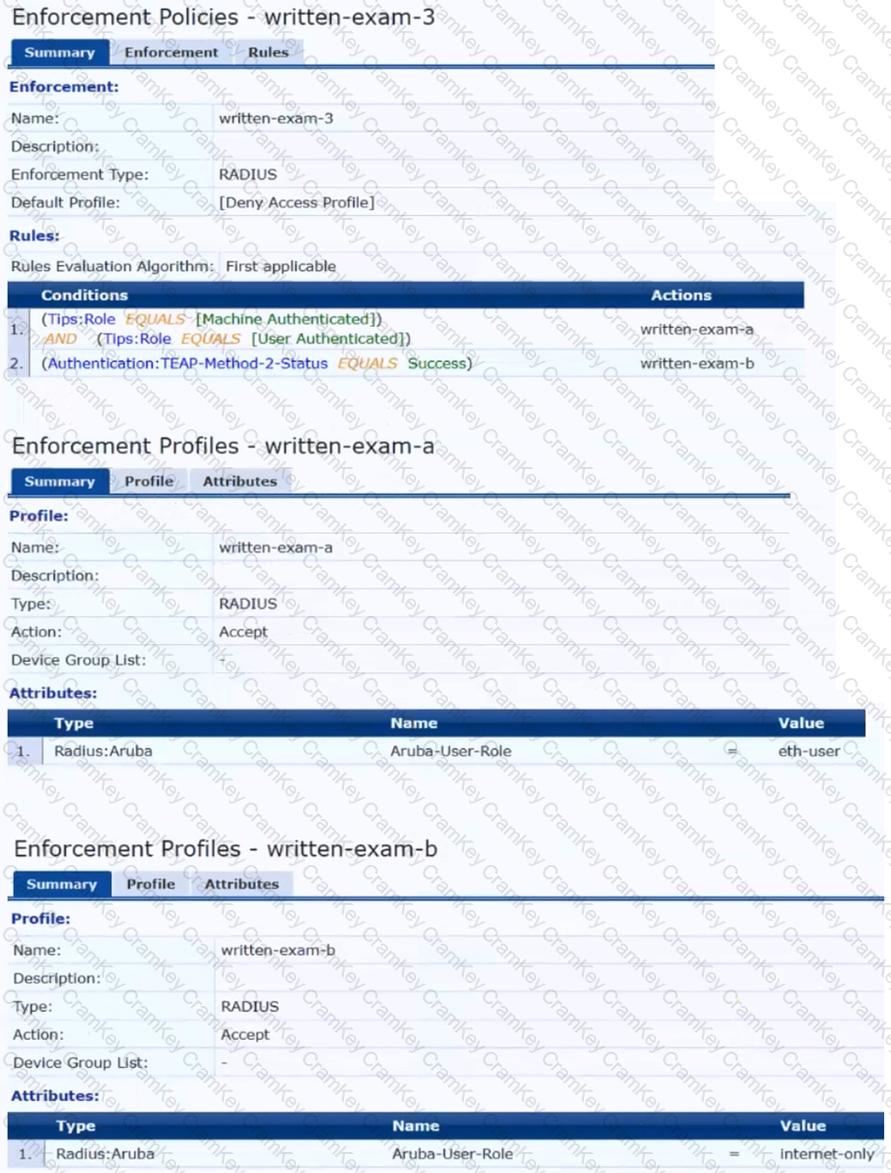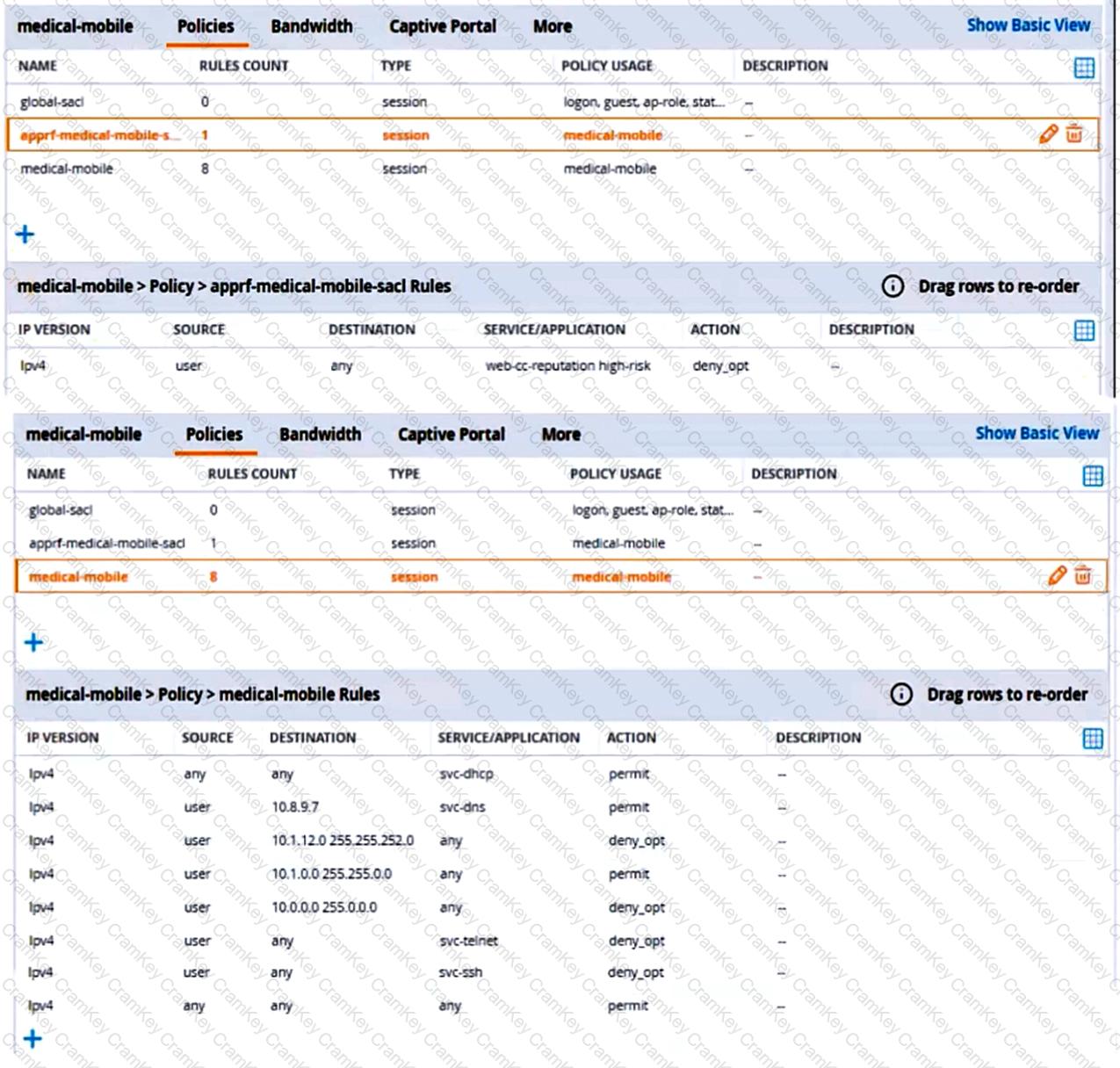| Exam Name: | Aruba Certified Network Security Expert Written Exam | ||
| Exam Code: | HPE6-A84 Dumps | ||
| Vendor: | HP | Certification: | ACA - Network Security |
| Questions: | 60 Q&A's | Shared By: | zayaan |
Refer to the scenario.
A customer is using an AOS 10 architecture with Aruba APs and Aruba gateways (two per site). Admins have implemented auto-site clustering for gateways with the default gateway mode disabled. WLANs use tunneled mode to the gateways.
The WLAN security is WPA3-Enterprise with authentication to an Aruba ClearPass Policy Manager (CPPM) cluster VIP. RADIUS communications use RADIUS, not RadSec.
For which devices does CPPM require network device entries?
The customer needs a way for users to enroll new wired clients in Intune. The clients should have limited access that only lets them enroll and receive certificates. You plan to set up these rights in an AOS-CX role named “provision.”
The customer’s security team dictates that you must limit these clients’ Internet access to only the necessary sites. Your switch software supports IPv4 and IPv6 addresses for the rules applied in the “provision” role.
What should you recommend?
Refer to the scenario.
A customer has an Aruba ClearPass cluster. The customer has AOS-CX switches that implement 802.1X authentication to ClearPass Policy Manager (CPPM).
Switches are using local port-access policies.
The customer wants to start tunneling wired clients that pass user authentication only to an Aruba gateway cluster. The gateway cluster should assign these clients to the “eth-internet" role. The gateway should also handle assigning clients to their VLAN, which is VLAN 20.
The plan for the enforcement policy and profiles is shown below:

The gateway cluster has two gateways with these IP addresses:
• Gateway 1
o VLAN 4085 (system IP) = 10.20.4.21
o VLAN 20 (users) = 10.20.20.1
o VLAN 4094 (WAN) = 198.51.100.14
• Gateway 2
o VLAN 4085 (system IP) = 10.20.4.22
o VLAN 20 (users) = 10.20.20.2
o VLAN 4094 (WAN) = 198.51.100.12
• VRRP on VLAN 20 = 10.20.20.254
The customer requires high availability for the tunnels between the switches and the gateway cluster. If one gateway falls, the other gateway should take over its tunnels. Also, the switch should be able to discover the gateway cluster regardless of whether one of the gateways is in the cluster.
What is one change that you should make to the solution?
Refer to the scenario.
A customer requires these rights for clients in the “medical-mobile” AOS firewall role on Aruba Mobility Controllers (MCs):
 Permitted to receive IP addresses with DHCP
Permitted to receive IP addresses with DHCP
 Permitted access to DNS services from 10.8.9.7 and no other server
Permitted access to DNS services from 10.8.9.7 and no other server
 Permitted access to all subnets in the 10.1.0.0/16 range except denied access to 10.1.12.0/22
Permitted access to all subnets in the 10.1.0.0/16 range except denied access to 10.1.12.0/22
 Denied access to other 10.0.0.0/8 subnets
Denied access to other 10.0.0.0/8 subnets
 Permitted access to the Internet
Permitted access to the Internet
 Denied access to the WLAN for a period of time if they send any SSH traffic
Denied access to the WLAN for a period of time if they send any SSH traffic
 Denied access to the WLAN for a period of time if they send any Telnet traffic
Denied access to the WLAN for a period of time if they send any Telnet traffic
 Denied access to all high-risk websites
Denied access to all high-risk websites
External devices should not be permitted to initiate sessions with “medical-mobile” clients, only send return traffic.
The exhibits below show the configuration for the role.

There are multiple issues with this configuration. What is one change you must make to meet the scenario requirements? (In the options, rules in a policy are referenced from top to bottom. For example, “medical-mobile” rule 1 is “ipv4 any any svc-dhcp permit,” and rule 8 is “ipv4 any any any permit”.)